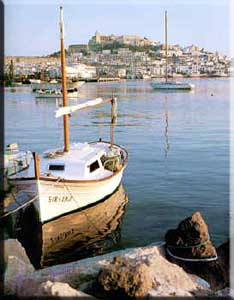Vacation Packages
Ibiza vacation packages
ibiza Hotels
- Ibiza luxury hotels 5*:
- Ibiza first class hotels 4*:
- Ibiza budget hotels 3*:
- Selection of gut rated hotels in Ibiza:
Splendid natural beaches, secluded little coves and rocky inlets with fine, white sand and diamond bright water all over the island.
Because Ibiza has no heavy industry, the waters are pollution free and every year many beaches are awarded the coveted EEC Blue Flags.

Ibiza vacation packages

Spanish drinks
Spanish Drinks Measures are definitely (hic) more generous (sometimes as much as triple!) than at home. So count three rounds for every one ordered and you'll stay happy enough to know you're having a good time. Spanish Beers are, on average, stronger than back home and can surprise the unwary, not to put too fine a point on it!
Local Drinks
'Sangria'
Spain's most famous drink, comes in a variety of recipes according to who's making it, but basically it's wine with added spirits, liqueurs, and chopped fruit. Thus red wine 'Sangria' may have apples, oranges, etc. white wine or champagne 'Sangria' pears, apple, banana etc.
Shops vary, but, in general, Department Stores And Hipermarkets stay open all day to late night, smaller shops from 9am to 1.30pm and 4pm to 8pm, or 10pm in high summer. A few shops close on Sundays and Fiestas
Local menus use Bacalao (Cod), Merluza (Hake), Emperador (Swordfish), Raya (Skate), Mero (Grouper), Lenguado (Sole), Rodaballo (Turbot) and delicious white meat fish you won't be used to, like Denton, Sirvia and the delicate tasting Dorada (baked in a salt jacket - yummy! - tastes just like lobster), Besugo (oven baked whole), Rape (Listen, I shall say this onlee once - you've gotta say rahpay!) and many more.
Order a 'Parrillada de Pescado' (Mixed Grill of Fish) or 'Zarzuela' (Fish Stew) and you will be presented with a selection of many of these.
The Spanish are great shellfish eaters and the variety here is enormous, ranging from Gambas (Prawns), Langostinos (King Prawns), Bogavanta (Lobster), Cigalas (Smaller, local chaps), Cangrejo (King Crabs), then there's Calamares (Squid), Pulpo (Octopus).
The Souvenirs and Gifts get better each season, there's always the perfect piece that the folks back home absolutely knew they couldn't live without till you've bought it!
As the Spanish are very kiddie-conscious, here's a great chance to make sure the little ones get something really different in toys and togs that are sure to please.
Spanish Leather & Suede is admired the world over for its incredibly soft and pliable qualities. Now is the best time to buy, at possibly the best prices in Europe.
Ibiza's tremendously artistic community will give you Truly Original Works of Art, ranging from paintings, silver jewellery, repro ceramics & glass through to charmingly imaginative gifts and souvenirs.

Ibiza - History
Ibiza has a history of human inhabitants that dates back approximately 3,000 years. The latest archaeological findings in Ibiza are estimated to be from 1600B.C., the rock paintings of 'Ses Fontanelles', San Antonio 800B.C. and disks and bronze axes of San Juan, Formentera and San Antonio 700B.C. The Carthaginians, who were merchants, founded Ibiza in 654B.C.
The Profession of these people is evident in the architecture such as Puig des Molins in Ibiza, which is a cemetery. The treasures found are now housed and able to be viewed at the museum in Via Romana, but the site it is easily accessible and a great place to visit.
Another couple of wonderful examples are Can Sor in San José and Es Cuieram, a temple in the honour of the goddess Tanit, in San Vicente.
Then, the Romans arrived, but trade such as salt extraction, fishing and agriculture, continued as normal. The Romans also left their mark in the form of S'Avgamassa, an Aqueduct in Santa Eulalia, the Roman 'castro' in San Fernando Village and the recently discovered statues, which have been replaced with replicas, in the old town of Ibiza and Plaza Luis Tur. The originals are now housed in D'alt Vila Museum.
A large gap lies between the 5th and 9th Centuries in Ibizan history. This was a time of barbarians and the Byzantines. The only remaining monument is the Church of Santa Ines and the catacombs. Later, the Arabs arrived leaving the indelible mark on Ibizan society, in the clothing, the architecture, customs and irrigation systems. Some examples of the architecture are the wall and fortified towers in the calle de San José, Casa Fajarnés and the access bridge linking calle de Santa Maria and Calle Mayor in D'alt Vila.
On August 8th 1235 the Catalans reconquered Ibiza. Formentera and Ibiza were incorporated and commonly known as the 'west'. The Catalans divided the island into four areas, and consequently, Catalan is still the language of the Ibizans and the Formenterians in its varied dialects. The Catalans built beautiful churches and the cathedrals, which is dedicated to Santa Maria, the patron saint of the island.
Ibiza was constantly raided and attacked because of its vast coastline and lack of political protection and interest.
The situation became so bad that the need arose to fortify the churches, which were then used as refuges during attacks.
In the 16th Century, the Renaissance wall was finally built, after much begging and badgering, to protect the island and its inhabitants. The wall measures 1,931M in length and a maximum height of 22M. Later towers were added and constantly manned to guard against pirates and other raiders. The Rural Architecture is also magnificent. The houses were built according to individual needs which resulted in a variance of size and opulence, depending on the wealth of the family. The most stunning and eye catching detail of the rural abodes and churches are that they all pristinely white washed, leading Santiago Rusi:ol to aptly name them the 'White Islands'.
Tags: Ibiza travel guide, vacation rentals, hotels, package holidays, points of interest, car rental, city breaks, weather